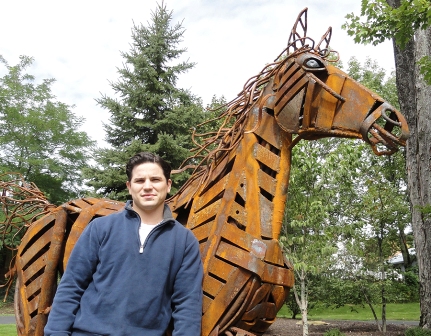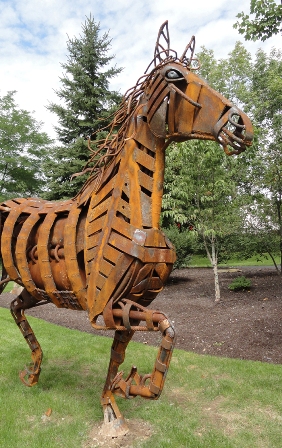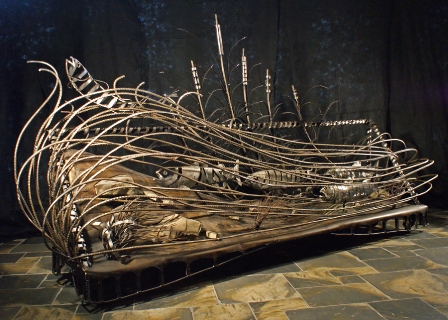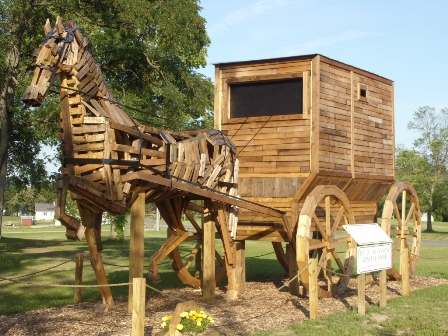I have something a little bit different to share with you guys today.
Chris McConnell, a talented artist living in Ohio, recently sent me an email with photos of a 1,900-pound steel horse that he constructed from recycled materials he found at a local junkyard.
I thought it would be interesting to talk with Chris about his artwork, which was inspired by such legendary Thoroughbreds as Phar Lap and Secretariat.
McConnell, 25, is a horse racing fan and has been an artist since he was 5. Currently a senior at the Cleveland Institute of Art, he has been doing large commission work for the last few years.
McConnell’s horse art, dubbed “the Steel-bred,” is a little larger than life size at 16’1 hands. The horse is owned by Gordon Safran, who keeps the structure at his Red Maple Inn, a popular bed and breakfast in Burton, Ohio.

“In all (Steel-bred) took four months to construct and install,” said McConnell. “All the steel that is used in the work is very thick, giving it the ability to last over a 100 years outside, and if treated, perhaps longer. All the steel was bent by hand forming its contour and parallel lines.”
Here is a series of questions I asked McConnell about himself and his equine art creation:
EM: Was there a particular horse that inspired you to create your art? Who and why?
CM: I used 82 horse pictures to render the steel horse. Some of the big name horses I worked from included Bourbon King (a prominent Saddlebred horse). I used this horse because he was very muscular.
I used Phar Lap because he was so tall. I wanted the steel horse to be large in stature so it was more noticeable to the eye, so I studied Phar.
I looked at Secretariat because he had great definition in his rear legs and it was easy to find photos of him.
.jpg)
Secretariat during his racing days. Photo from Blood-Horse Library
My neighbor has a horse that was a mixed breed that I would use to find the over-all form. I looked at a lot of horses for the project, all of which helped in the final product of the horse.
EM: Tell me the specifics about the steel horse. What methods did you use to construct it?
CM: Building the horse would be chaotic without a system and a sense of organization to abide by. For this reason I came up with three words to direct my efforts: elegance, quality, and form. In using these words I decided the contour line would be most important in this work. The line works in a dynamic way-- to show direction and muscle mass. Quality was used to create the best possible form (form meaning horse.). How the different steel parts work in unison, and how the welds are all comfortably placed, were constructed with the word quality in mind.

Chris McConnell with "the Steel-bred"
The decision of style and aesthetics of the spacing and organization of the steel was a big part of the work as well. In the last three years I have been studying Asian philosophies and culture. The Taoist’s talk about the space as being more than the thing--in using space to create a second dimension the viewer begins to realize a different translucent aspect that breaks up the impact in which the steel radiates. Also the work seems lighter with the gaps, giving it a faster feel.
Weight distribution was also a major concern for me. How should I place the material to create a fluent, dynamic, and yet organic feel that a horse has? These kinds of questions I asked myself constantly throughout the construction. In doing so the horse has what we call in the fine-arts world, a contrapposto. Buried in this twisting and pulling steel it acts like a moving organism.

The materials that I used were selected very special for this work. I did not want to show many known parts; this was to avoid the ketch effect that is sometime associated with recycled art.
Instead, I used the steel as a medium, like, clay or paint. Some of the parts used were: propane tank, truck leaf springs, truck drive shaft swivel, three air tanks that would be used to fill a tire, re-bar, implements from tractors, as well as many different sized pipes.
EM: Do you have an interest in horse racing? Tell me a little bit about your background.
CM: I do enjoy horse racing; I find it to be very exciting and fun to watch. I have been around horses all my life, though my parents never owned them. A few years ago I worked at a private barn that trained Dressage horses. I then got a job working at one of the most prestigious fox hunting clubs in Ohio called the Chagrin Valley Hunt Club. I would help clear the paths so the members could ride through. I worked there for two years before going to The Cleveland Institute of Art.
EM: What kind of response have you received from the Steel-bred so far?
CM: All the responses have been good. People have told me they like the fact that it's running, (or appears to be in motion). It makes it more life-like.
EM: Why do you feel like public art such as this is important?
CM: I see a lot great work placed in the public realm. The artists are doing those locations a favor; one they’re creating a land mark that people will always remember, and two, If the work is done right, it can be a life changing experience for those who view it.
EM: Have you constructed any other similar structures? Do you plan do this as a profession?
CM: Some my other recycled sculptures include a 15X34-foot horse in buggy, which has become a tourist attraction in Mesopotamia Township, Ohio; and a 12X6-foot fish, now located in downtown Cleveland, at the Galleria.


I have had 35 different jobs in my life so far, manual jobs like milking cows, tree service, washing dishes, stocking shelves. I have a degree in auto body and landscaping, to list a few. Working all those jobs makes me appreciate what I do now, and I'm my own boss finally.
EM: Thanks for sharing the story of “the Steel-bred” with us, Chris!
************************************************************************
Do any of you have a favorite piece of Thoroughbred-related art? What is it and why do you love it?




